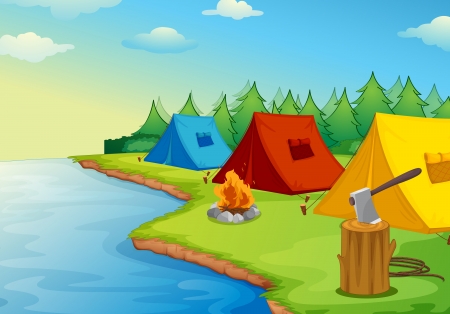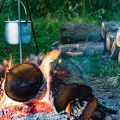Introduction: Gathering Around the Flames
There is something undeniably stirring about the soft crackle of a campfire under a British sky, where stories and laughter rise with the smoke into the cool air. Since time immemorial, people across these isles have gathered around flames for warmth, companionship, and nourishment—a simple act that has woven itself into the very fabric of British culture. The tradition of sharing meals by firelight stretches from ancient tribal hearths to today’s bustling campsites in the Lake District or along Cornish cliffs, each flame kindling a sense of togetherness and belonging. This journey through the history of traditional British campfire meals invites you to wander through misty woodlands and windswept moors, to taste the hearty fare that has sustained generations, and to revel in the gentle beauty of communal life beneath the stars. As we trace this evocative lineage from our ancestors rustic gatherings to modern outdoor adventures, we discover not just recipes but rituals—reminders of how food, fire, and fellowship remain at the heart of Britain’s enduring spirit.
Ancient Hearths: Early British Campfire Fare
Long before the convenience of modern camping stoves, the ancient Britons gathered around open flames, finding both sustenance and solace in the glow of communal fires. The tradition of campfire cooking in Britain stretches back to prehistoric times, weaving through the misty moors and wooded glens, where survival depended on ingenuity and a close relationship with nature. These early meals were shaped by necessity—simple yet hearty fare that echoed the rhythms of the land.
The Simplicity of Foraged Feasts
Foraging was central to ancient British diets. Wild herbs, nuts, berries, roots, and edible greens made their way into pots and onto stones placed at the fire’s edge. Such ingredients not only provided essential nutrition but also infused meals with the subtle flavours of the British countryside. The practice of gathering wild foods is a living tradition, echoing Celtic reverence for the natural world.
Spit-Roasted Game and Shared Abundance
Meat was a coveted delicacy, often reserved for communal gatherings or feasts. Hunters brought back game such as venison, boar, rabbit, or wild fowl, which would be carefully prepared and spit-roasted over crackling embers. This method imparted a smoky depth to the meat while encouraging fellowship as people waited together for the meal to cook. Below is a glimpse of typical fare from these ancient hearths:
| Food Source | Preparation Method | Cultural Significance |
|---|---|---|
| Foraged Berries & Nuts | Boiled in stews or eaten raw | Sustenance during lean seasons |
| Wild Herbs & Roots | Roasted in embers or added to broths | Believed to have healing properties |
| Game Meat (Deer, Boar) | Spit-roasted over fire | Shared at feasts; symbol of abundance |
| Fish from Rivers & Lakes | Baked in clay or grilled on sticks | Common along Celtic waterways |
The Communal Fire: Heart of Celtic and Anglo-Saxon Life
The campfire was far more than a means to prepare food—it was a sacred centrepiece for storytelling, song, and social bonding. In both Celtic and later Anglo-Saxon cultures, gathering at the fire represented unity and continuity. Meals cooked over these ancient flames became rituals in themselves: simple yet profound acts linking generations through taste, warmth, and memory. Even today, echoes of these traditions linger whenever we light a campfire beneath an open sky.

3. Medieval Camps and Fireside Feasts
As the Middle Ages dawned, the British landscape was dotted with sprawling woodlands, rolling meadows, and stone keeps echoing the distant beat of horses’ hooves. In these times, campfire cooking was both a necessity and a cherished ritual—woven seamlessly into daily life, royal expeditions, and humble village gatherings alike.
Beneath the flickering glow of open flames, travellers and soldiers alike would gather to simmer hearty stews in iron cauldrons, their aromas mingling with the smoky air. These stews were often a medley of root vegetables—turnips, leeks, and carrots—interlaced with wild herbs foraged from hedgerows and whatever game could be snared or hunted: rabbit, venison, or wildfowl. The slow bubbling of broth over embers became a comforting soundtrack to tales swapped under star-stitched skies.
Roasted meats were another fireside staple, especially during royal hunts when aristocrats ventured into forests with retinues in tow. Spits fashioned from green wood would cradle whole haunches of venison or boar above glowing coals, turning them steadily until the skins crisped and juices sizzled into the fire. These feasts were not merely sustenance but celebratory affairs—moments where the boundary between peasant and noble blurred around shared platters and laughter carried on the wind.
The medieval campfire also served as the heart of village festivals and seasonal gatherings. Here, cooks would bake flatbreads on hot stones or wrap dough around sticks to make simple yet satisfying treats. Ale flowed freely while songs rose in harmony with crackling flames, weaving community together through shared warmth and flavour.
With every meal prepared under open skies, traditions evolved—recipes passed down through generations, adapting subtly with each telling. Campfire cooking in medieval Britain was thus more than a means of survival; it was an art form shaped by necessity but elevated by camaraderie and celebration—a living heritage that still flickers in today’s camping rituals across the British countryside.
4. Victorian Rambles: Picnics and Pies by the Fire
The Victorian era marked a new dawn for British outdoor leisure, as rambling through the countryside became a fashionable pastime for both city-dwellers and rural folk alike. With railways unfurling their silver lines across the landscape, families and friends found it ever easier to escape to meadows and woodlands, baskets in hand and spirits high. The campfire was no longer just a necessity for survival; it became the heart of convivial gatherings, where laughter mingled with the aroma of baking pies and toasting bread.
Victorian picnics were delightfully elaborate affairs, often featuring starched linens spread over wild grass, delicate crockery, and a smorgasbord of hearty fare. At the centre of these feasts were savoury meat pies – portable, filling, and perfectly suited to open-air enjoyment. Campfires flickered under ancient oaks as pies warmed gently on grates, their golden crusts crisping in the gentle heat while slices of bread browned at the edges, ready to be slathered with homemade preserves or fresh butter churned from nearby dairies.
Perhaps nothing embodies the spirit of Victorian outdoor living more than the ritual of brewing tea by the fireside. A battered kettle would be nestled among glowing embers, its steam rising in curling wisps as water bubbled merrily within. The simple pleasure of sharing a hot cup of tea beneath vast English skies became a cherished tradition—a soothing comfort after a day’s ramble.
| Typical Victorian Campfire Meal | Description | Cultural Significance |
|---|---|---|
| Meat Pies | Savoury pies filled with beef, mutton, or game; baked ahead or finished over campfire coals | Symbolised abundance and practicality; ideal for travel and communal eating |
| Toasted Breads | Thick slices of farmhouse loaf toasted over flames, served with butter or jam | A rustic treat reflecting Britain’s agricultural heritage |
| Campfire Tea | Loose leaf tea brewed in a kettle directly on the fire | Became an essential part of British outdoor leisure culture |
This period fostered not only new traditions but also an appreciation for beauty in simple moments—sunlight dappling through leaves, the warmth of fire on chilled hands, and flavours deepened by smoke and good company. In every aspect, Victorian rambling wove together the pleasures of nature, nourishment, and camaraderie—a legacy that still shapes British camping meals today.
5. Wartime Rations and Scouts Suppers
The echoes of Britain’s turbulent twentieth century—particularly the World Wars—can be tasted in the humble campfire fare that endures to this day. As rationing swept through households, creativity was summoned from necessity, and simple ingredients became the heart of outdoor meals. The memory of ration books lingers in dishes like ‘Eggy Bread’, a frugal yet satisfying treat made by soaking stale slices in beaten egg, frying them over a crackling fire until golden, and savouring every bite as both comfort and sustenance.
The influence of the Scout movement cannot be understated in shaping British campfire cuisine. Since Robert Baden-Powell’s founding of the Scouts in 1907 on Brownsea Island, generations have gathered around glowing embers, learning resourcefulness and camaraderie alongside the art of outdoor cookery. Baked potatoes buried deep in hot ashes became a rite of passage—crisp-skinned, smoky, and warming to both fingers and soul after a day exploring moors or woods. Such meals are not merely about nourishment; they form cherished rituals, shared under starlit skies with companions and cups of strong tea brewed in battered billycans.
Wartime restrictions also inspired inventive uses for whatever was at hand—tins of corned beef transformed into hearty hash, wild greens foraged to enrich soups, even condensed milk whisked into sweet puddings. The ethos was clear: waste nothing, savour everything. These traditions linger in today’s camping experiences, woven into the very fabric of British outdoor life—a testament to resilience and a quiet celebration of simplicity around the fireside.
6. Modern Camping: Reinventing Tradition
As tents unfurl beneath the wild British sky and the scent of woodsmoke lingers in the crisp air, a new chapter in the story of campfire cuisine is being written. Today’s campers, with rucksacks brimming with both nostalgia and innovation, are breathing fresh life into age-old recipes while embracing the abundant treasures of local landscapes.
The Revival of Classic Recipes
Contemporary camping meals often pay homage to their rustic roots—think bubbling pots of stew or hearty baked potatoes tucked into embers—but they also benefit from a culinary renaissance. Across campsites from Cornwall’s windswept cliffs to the rolling peaks of the Lake District, traditional favourites like sausage rolls or damper bread are being lovingly revived. Yet these classics now come flecked with modern twists: sourdough starters replace plain flour, wild garlic plucked from woodland paths infuses butter, and heritage meats sourced from local farms grace skewers over glowing coals.
Reimagining by the Fireside
This reimagining isn’t just about ingredients; it’s about experience. Campers experiment with cast iron cookware, create inventive foil parcels packed with seasonal veg, and even attempt delicate puddings steamed in enamel mugs over open flames. Evening tales are swapped over smoky venison burgers or freshly foraged mushroom risottos—meals that capture both the spirit of adventure and a reverence for Britain’s edible heritage.
The Role of Seasonal & Local Ingredients
Central to this fireside renaissance is an appreciation for what grows close at hand. Wild berries picked at dawn sweeten morning porridge, while fresh-caught trout sizzles beside buttered new potatoes and sprigs of hedgerow herbs. British campers increasingly seek out farmers’ markets en route to their chosen patch of green, filling baskets with rhubarb, asparagus, or Somerset cheese—ingredients that root each meal in its particular landscape and season.
In this way, modern British campfire meals become more than sustenance—they are vibrant celebrations of place and time. As flames dance beneath starlit skies, every shared bite offers a connection to history and to the living bounty of the British countryside.
7. Conclusion: Campfire Meals as a Living Heritage
There is something ineffably British about gathering around a glowing campfire, the air tinged with woodsmoke and laughter, sharing simple food under an open sky. Across centuries—from ancient Britons roasting wild game to Victorian explorers simmering hearty stews in battered pots, and right up to today’s families grilling sausages at weekend campsites—these traditions have woven a living tapestry of communal spirit and creativity. Cooking outdoors invites us to slow down, savour each moment, and find connection not only with nature but also with those around us. In every sizzling rasher of bacon or golden baked potato, we taste the legacy of generations who understood that warmth and flavour are as much about people as they are about food. As modern campers embrace both time-honoured recipes and contemporary twists, the tradition remains vibrant—a living heritage that brings joy, sustenance, and togetherness to British outdoor life, year after year.


